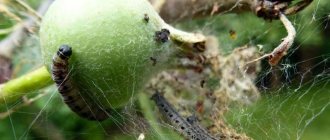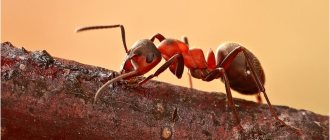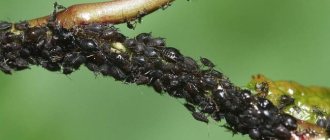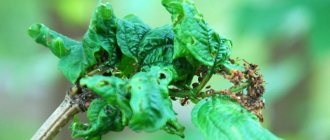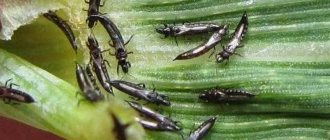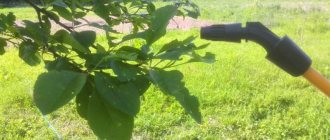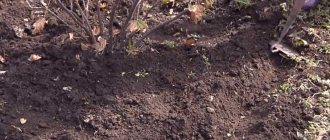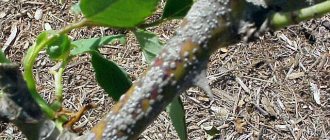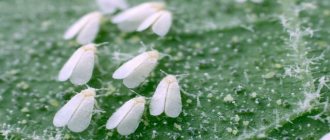How to get rid of aphids and sometimes save not just the crop, but the plant itself from death is a headache for gardeners and indoor plant lovers. Often gardeners (whether professional or amateur) are faced with the problem of aphids attacking fruit trees, flower or berry bushes and other garden crops.
In the spring, when young shoots appear on the plants, aphids begin vigorous activity from the lower part of the leaves: each individual is literally absorbed into the plant tissue, drying them out. Because of this, the plant begins to wither, the leaves fall off, and the branches dry out.
As a result, the plant dies. But this is not the only danger of aphids. These insects are known to spread viral diseases that are dangerous to plants. Such a virus causes the development of anomalies in the form of gall-like formations that weaken the plant, causing it to die. Therefore, you should know how to get rid of aphids. And it doesn’t matter where the insects started their activity - on trees or bushes - it is recommended to destroy them in any case if you need to save the crop.
Aphids - what kind of insect is this?
Aphids (in everyday life the name “aphid” is more common) are small insects, the size of which barely reaches a couple of millimeters. Although the size of some individuals is 5-7 mm. Aphids belong to the order Hemiptera of the superfamily of insects. According to the data, there are a total of 10 families of this pest and about 4 thousand of its species. Moreover, some species prefer to feed on a certain plant, while others live on trees and bushes.
Aphids are phytophagous - herbivorous insects. They pierce leaves or shoots with their proboscis and feed on their juice. They reproduce without the process of fertilization, that is, by parthenogenesis. Interestingly, at the peak of their activity, which occurs in June, aphids give birth to winged offspring. But this only happens if the plant that the insect family has chosen begins to die, and the pests need to look for a new “host”. Thus, the winged offspring flies to a new plant, where they successfully continue their life cycle.
Aphids belong to the order Homoptera. The color of insects can be gray, green, black insects are often found, and orange ones are less common. Despite their tiny size, aphids are very noticeable on plants, since they settle on the “host” in entire families, clinging to stems, leaves, shoots, and buds. Insects do not disdain indoor plants either. That is why everyone should know how to get rid of aphids in order to be able to save plants from this scourge.
Why is a garden guest dangerous?
When to prune trees and how to cover cuts on fruit trees
High-quality control of aphids on young or mature fruit trees in the garden helps maintain health indicators and increase productivity. Up to 90% of people encounter the presence of aphids. That is why it is important to know why it is dangerous. The first thing to remember is that the size of the insect is too small to be seen with the naked eye. Leaves and wood are damaged. The size of individuals averages 0.3 mm, some reach 0.5 mm. Rarely are aphids larger than 7 mm. Insect colonies increase very quickly. Therefore, it is necessary to apply control and prevention measures immediately.
Important! The first sign of a fruit tree infestation with aphids is the appearance of a small black dot on the inside of the leaf blade.
The rapid development of the colony is achieved due to the ability of aphids to migrate - insects have wings, which allows them to fly to other trees. Garden treatment must be comprehensive. It is necessary to influence all trees and plants adjacent to them, since aphids move in search of an optimal habitat for themselves. Wingless individuals can also cause disease in plantings and fruit crops. The following must be processed:
- trees;
- ornamental bushes;
- flowers;
- fruit bush
- decorative plantings - small trees, vines;
- vegetable crops.
Leaves are the first to be affected by aphids.
For the normal functioning of an aphid colony, moisture is necessary. With the help of a proboscis, the insect pierces the soft tissues of leaves or buds. After this, the plant’s metabolism of nutrients is disrupted, and the access of amino acids to the damaged area is stopped. As a result, part of the plant or leaf does not develop and dries out.
It is visually easy to determine that the plantings have been damaged by an insect colony. A gardener can observe while planting:
- early leaf fall (this does not happen around or among neighbors);
- the leaf blade changes: its edge curls, becomes darker, dries out;
- if aphids damage not fruit trees, but the plantings around them, then their stems become deformed;
- growths of varying intensity and severity are observed on the tree trunk;
- buds and ovaries fall off.
As a result, the yield rate decreases. Additionally, it is observed how the overall growth of a shrub or fruit tree slows down.
Important! The damaged plant weakens rapidly. If you do not take timely measures to get rid of pests, then the likelihood that it will die in the winter increases.
Aphids leave waste products that contain sugary substances on the leaves or trunk of a tree. The coating is called honeydew. As a result, the natural processes of photosynthesis are disrupted. The fungus actively multiplies on the leaf plate. The danger from aphids also comes from their ability to quickly transmit various viral diseases, which lead to the weakening and death of bushes, trees and other cultural plantings. Timely and competent care of crops can prevent the problem. Additional protection will be the implementation of preventive measures and the gradual destruction of colonies. Chemical, biological and folk methods are used for this purpose.
What damage does aphids cause to trees and bushes?
Gardeners often underestimate the damage that aphids cause to plants. And completely in vain. After all, these pests, gathering in huge groups on the “host” plant, feed on its sap until it begins to die. A bush or tree where aphids live slows down its growth, its leaves curl, its buds and shoots become deformed, and its fruits do not ripen. Such a plant is unlikely to survive the winter; most likely, by spring it will simply dry out.
In addition, aphids transmit viral diseases: during the life of insects, a sugary substance called honeydew is released, which is an excellent basis for the development of black sooty mildew. This fungus destroys the plant and causes it to rot.
It is interesting that aphids drink juice from plants not as much as they need for normal life, but several times more. Their body, unable to cope with such an amount of food, removes the remaining plant juice in the form of sugary secretions - honeydew. This substance is quite sticky. Enveloping the surface of the plant, honeydew prevents their cells from breathing. In addition, this sweet liquid is a good substrate for the development of sooty fungi, which cover the leaves with a solid black layer, preventing natural photosynthesis, thereby inhibiting the weakened plant.
Green aphids attack plant roots. Because of this, they weaken and die over time. What’s also scary is that this pest transfers viral diseases from plant to plant during its migration in search of a new “host”. And since it is possible to get rid of aphids, this should be done immediately, as soon as the first groups of this insect were discovered. Otherwise, there is a high probability that aphids will destroy the plants of the entire area.
Natural enemies
Natural enemies of aphids can be both insects and birds that feed on adults and their larvae. They effectively help in pest control. Gardeners should think about bringing to the site:
- ladybugs;
- lacewing;
- hoverflies;
- sand wasps;
- cicadas;
- ground beetles
Birds can destroy most of the aphids:
- sparrows;
- tits;
- warblers;
- kings;
- robins;
- robins.
In order for natural helpers to cope with their task, you need to know how to attract them. For example, hoverflies flock to dill, parsley and similar herbs; earwigs are ready to colonize containers with fresh wood shavings. Birds can be provided with comfortable birdhouses, tree feeders, and special drinking bowls. When creating favorable conditions for beneficial living creatures, remember that the use of pesticides on the site restrains and suppresses their development.
What trees and bushes do aphids live on?
By and large, aphids don’t care which bush or tree becomes its habitat and food. These can be fruit plants, various shrubs, flowers, and vegetables. But there are plants that this pest especially loves:
- currant;
- tomatoes;
- cucumbers and melons;
- gooseberry;
- Apple tree;
- legumes;
- roses;
- cornflowers;
- carnations and chrysanthemums;
- bulbous flowers;
- walnuts;
- zucchini and pumpkin;
- potatoes and beets;
- salad and others.
It is worth noting that aphids prefer to settle on trees and bushes that have just opened leaves or buds. That is, the plant must be young - old and hard leaves are not of interest to the pest, since their tiny proboscis will not be able to pierce the surface of the leaves, which means that aphids will not be able to feed on the sap of “old” plants. However, this does not mean at all that such trees and bushes are safe: aphids willingly settle on the tops of plants and under the lower part of the leaves, that is, where the parts of the plants are the youngest and softest.
Signs of pests
Aphids have a round or oval shape. The parasite is from 1 to 5 mm in length. Small individuals can be less than a millimeter. Particularly large – up to 8 mm. Aphids come in several colors depending on the species: green, red, pink, black, yellow, and also transparent.
It is quite simple to understand that pests have appeared on plants. This is signaled by:
- dried and curled leaves;
- tree trunks and branches are covered with mucus;
- deformed shoots;
- weakened flower stems;
- fallen buds.
Aphids can be seen with the naked eye. The insect moves in colonies, so the infected area will have several dozen parasites at the same time. Pests prefer to settle on the leaves from the inside. They can also be found on the top of plants.
How to get rid of aphids on trees and bushes: fighting ants
Probably every gardener or gardener has observed how ants scurry around a group of aphids, and in fairly large quantities. But very few people know that ants do not eat these pests, but quite the contrary, they protect them from other insects that are not averse to feasting on them. What is the reason for this partnership? And is there a connection between these insects?
Surprisingly, there is a connection. And the most unexpected one! The fact is that the ants themselves bring aphids to young plants. For what? It's simple: as mentioned earlier, aphids secrete a sweet sticky liquid from their bodies - honeydew. And the ants feed on this honeydew. That is, ants protect aphids from other insects, and they, in turn, thank them with nutritious and tasty food.
But that's not all. There are types of aphids that wait for their patrons, that is, ants, and only when they tickle them with their antennae do they give up honeydew. It turns out that the ants “milk” their insects. In return, they provide them with luxurious pastures, protect them from enemies, build “roofs” and “houses” so that birds and other ants do not find aphids, fight off their feeders from other insects... All summer, ants protect their aphids, and for the winter they take them to anthills, keeping an eye on them. not only for adults, but also for their eggs. The symbiosis of aphids and ants is so strong that when the latter change their habitat, they take their pets with them.
So it turns out that in order to understand how to get rid of aphids, you must immediately take measures to destroy the ants, which are the cause of the appearance of these pests.
conclusions
- Aphids are a dangerous pest that can kill not only the crop, but also the plants themselves.
- To get rid of insects, you don’t have to buy store-bought chemicals; you can use traditional methods.
- Soap solutions, herbal and plant infusions and decoctions, as well as solutions from improvised means are suitable for disposal.
- Traditional recipes are used regardless of the stage of plant development, which is an absolute advantage over chemicals that are harmful during the period of flowering and ripening of fruits.
- To get rid of aphids once and for all, carry out preventive measures in the spring and regular treatment in the summer.
How to get rid of aphids: professional help
If the gardening area is too large, you cannot do without professional help. You need to understand that if aphids have settled only on bushes, then soon they can be observed on the trees of the area. And everything would be fine, but these insects destroy plant after plant, after which it is impossible to save either the crop or the plant itself. But in what ways do professionals fight aphids?
Chemical methods
This method is effective, but you need to remember that by killing aphids, you are killing other insects, which are a natural pest threat. If this fact does not bother you, then you should choose drugs that have a contact, intestinal and general effect on pests.
Contact preparations penetrate the skin of aphids. Intestinal products enter the parasites along with food. As a result, the aphids die from paralysis.
General-action drugs are absorbed into the plant tissue and remain there for a month. Such products are not washed off by rain. Aphids, eating plants treated with such chemicals, quickly die. However, these drugs cannot be used when the crop is set and ripening, since the substances contained in the chemicals are dangerous to humans.
Cold fog generators
cold fog generator
It is worth understanding that professionals know better how to get rid of aphids quickly and efficiently. And one of the effective methods is a cold fog generator. What is he? Essentially, this is a method of aerosol spraying a mixture of water and the desired chemical. Such generators operate on electricity, and therefore allow processing of offices, residential premises, small enterprises, greenhouses, shops and technical (industrial) premises.
The advantage of the method is that already 2-4 hours after treatment you can use the room as usual. The only negative: when spraying the working solution in the room, the air humidity may temporarily increase. Therefore, it is recommended to remove or cover the equipment before processing them. The air humidity will be restored after the room is ventilated.
Hot fog generators
Hot fog is produced in a special way: the working solution enters the gas, which moves at high speed. As a result, the solution turns into an aerosol. Microscopic drops, connecting with the cold air of the environment, instantly transform into a foggy cloud. Thus, the solution easily penetrates into all cracks and surfaces and settles on bushes and trees.
To prepare a working solution for hot fog generators, use water, glycerin, petroleum jelly, kerosene, and, less often, vegetable oil. Livestock farms, greenhouses, and open areas such as parks, orchards, and vegetable gardens can be treated with hot fog against pests. You need to maintain exposure after treatment for 2-4 hours with good ventilation.
Biological products to protect plant health
Organic-based products can protect the site no less effectively than chemical products. At the same time, biological preparations are harmless to humans and plants. The following biological products are trusted by gardeners:
- Arrow is a powder that simultaneously eliminates aphids and feeds the plant. To prepare the solution, take 50 g of powder and 10 liters of water. The effect is noticeable already on the third day after treatment.
- Fufanon is a fast-acting organophosphorus emulsion. Paralysis of the insect occurs after 2 hours, and within a day the pest dies. Sold in ampoules from 1.5 to 10 ml. It is not recommended to mix with other pest control products. To spray the crowns of trees and shrubs, you need to dissolve 10 ml in a bucket of water. To process a small bush, 1.5 liters are required. It should be sprayed before flowering; in case of severe infection, the procedure is repeated 2-3 times.
- Fitoverm for plants is a product in ampoules and bottles from which a solution for spraying is prepared. The dosage depends on the degree of spread of the pest and on average is 5 ml of the substance per 0.6 liter of water. After treatment, the effect of Fitoverm lasts for three weeks.
Fitoverm in ampoule
When working with biological products, it should be taken into account that rain reduces their effectiveness. It is recommended to repeat the treatment the next day after a rainstorm. If the weather is dry, spraying is carried out on the 12th day.
Traditional methods
What people can come up with to get rid of aphids. In fact, there are a lot of traditional methods of combating these insects. And they are all effective in their own way. However, it is worth considering the fact that any folk remedy destroys not only pests, but also beneficial insects. And in order for the effectiveness of the products to be higher, it is recommended to treat plants in the evening, when the guard ants go to spend the night in the anthill - this will eliminate the possibility of them saving aphids. Let's look at some of the simplest and most effective ways to combat aphids.
Water and liquid soap
In a spray bottle, dilute 2 cups of water and 2 tsp. liquid soap (you can use dishwashing detergent). Additionally, you can add a glass of vegetable oil, although this component is not mandatory.
Treat shrubs affected by aphids with this solution in the evening, carefully spraying in areas where pests are abundant. Repeat the procedure for several days in a row until the aphids disappear.
Garlic infusion
For infusion, take:
- 3-5 cloves of garlic (chopped with a press);
- 0.5 l of water;
- 2 tsp vegetable oil;
- 1 tsp detergent (liquid soap).
Crushed garlic is infused for at least 24 hours in water. Then add detergent and oil, mix, pour into a container that can be tightly closed with a lid. Before use, the solution (in the amount of 2 tablespoons) is poured into a spray bottle and the plants affected by aphids are treated.
Plant infusions
An infusion for treating trees, bushes and flowers against aphids can be made based on tobacco leaves, tansy, sophora, onion, celandine, marigold or wormwood. Any of these plants is crushed and poured into a bucket with warm water. Cover the mixture tightly and leave for 24-48 hours. Next, the solution is taken into a spray bottle and the plants are treated against aphids.
Decoction or infusion of celandine
Celandine helps people with many diseases. But this plant is also very effective in the fight against aphids. Celandine is collected during its flowering period (the entire bush is used). When crushed, you should get 300-400 g of fresh herb (or 100 g of dry). Pour celandine into 1 liter of water, boil for 30 minutes or leave for 1-1.5 days, tightly closing the container. When the infusion (decoction) is ready, treat the plants against aphids by spraying the solution from a spray bottle.
Wood ash
Our grandparents used this wood burning product to fight aphids. Prepare a solution from wood ash as follows: take 2 cups of ash per bucket of water (10 l). Leave the solution for at least a day. Dilute 50 g of laundry soap into the infusion, after which the plant is treated by spraying.
Other folk methods
It is known that the appearance of ants on trees and bushes directly depends on the appearance of aphids on these plants. Therefore, it is important to prevent ants from crawling on trees. To do this, you can wrap the tree trunk with adhesive material, sticky side out. You can treat the lower part of the trunk with an adhesive substance, but you should first make sure that it will not harm the tree. These simple steps will repel ants from trees, which means they will not be able to spread aphids along the trunks and leaves.
Dandelion officinalis in the amount of 300 g if the root is used, or 400 g if fresh leaves are used, finely chopped. Then add the herb to 10 liters of warm water (no more than 400C) and leave to infuse for a couple of hours. Before use, filter the infusion, pour it into a spray bottle and spray the affected plants.
Most pests can be washed off with a strong stream of water. Individuals that were washed to the ground no longer return to the plant. The honeydew is also washed off this way. All this helps reduce the aphid population. It is important to carry out this procedure in the morning: during the day the plants will dry quickly, which will prevent the development of fungal diseases.
Traditional methods of killing aphids on trees and bushes are good because they are absolutely safe, since natural products are used for their preparation. Despite this, the effectiveness of such means is good, although the result does not come instantly. Thus, treatment with each of these agents should be carried out 2-3 times, with an interval of 5-7 days. If this is not done, the pest will return to the plants, and subsequent treatment with the same product will be ineffective, since the aphids adapt to its composition.
Treating trees in the spring against pests and diseases
A gardener must know how to protect and protect trees from ants, aphids and other pests. Spraying and timely treatment reduce the likelihood of diseases. For an effective impact, you need to maintain proportions and spray and process strictly on time.
When to treat trees for pests in spring
Fertilizing fruit trees and shrubs in spring and fertilizing the soil
You can spray for the first time in early spring. If chemicals are chosen, the period should be before leaf bloom or after harvest. If biological or folk remedies are chosen, the treatment is carried out in several stages.
Spraying and processing using traditional methods are carried out:
- at the moment of bud break;
- during the flowering period;
- during the period of ovary formation.
Important! During the growing season, you can use products based on living microorganisms. Chemicals can be sprayed before the ovaries appear and 3-4 weeks before harvest.
How to spray fruit trees in spring
The early period (beginning of spring) involves treating fruit trees with a solution of lime and copper sulfate. Bordeaux infusion should be used for the reason that copper sulfate is an effective protection against diseases, pests and fungi. The spraying method is effective, but must be carried out in several steps:
- until the buds swell;
- at the moment of bud opening (a 3% solution is used);
- during the growing season (1% solution).
The ready-to-use solution has a light blue tint and slightly alkaline acidity. If the shade is green, then the composition is not suitable for use. You should also not add iron component (Fe) or laundry soap. They can cause excessive amounts of copper salts in the soil.
In order to protect the garden plot and fruit trees, when aphids have already appeared, chemical agents are used. They have a targeted effect and are guaranteed to eliminate pests. Examples of products are Fitoferm, Aktara.
Preventative work
The following measures will help reduce the likelihood of aphid colony formation:
- mowing grass near trees in spring and autumn;
- elimination of anthills;
- whitewashing trunks and lower parts of bushes.
Additionally, it is recommended to monitor the health of the plantings - on sick and weakened trees, aphids form colonies faster. Adding ash and lime to the soil will allow the plantings to receive the optimal amount of nutrients.
How to reduce the risk of plant infection by parasitic insects? Properly selected plants - neighbors - will help protect the orchard. Parasites do not like strong odors, so it is recommended to plant dill or onions. Coriander and apple tree are a good option for a neighborhood. Beds with onions or garlic in close proximity reduce the risk of infection by parasitic insects due to the presence of a pungent odor in the crops.
Prevention of aphids on the site
It is easier to prevent any pest invasion than to deal with them later. Therefore, in order not to rack your brains in the future about how to get rid of aphids, it is important to follow these rules:
- Carefully and carefully inspect seedlings and seedlings before planting them. Without sparing, destroy the planting material on which there is even the slightest hint of the presence of aphids.
- Before planting garden and vegetable crops, you should carefully inspect the areas adjacent to the site and exclude sources of the aphid family. If such places are found, exterminate the pests using any method.
- It is recommended to plant carrots, dill and parsley around the beds with vegetables that aphids love - these plants will attract aphid fighters - hoverflies, as a result of which the problem will gradually solve itself.
- The paths between the beds can be sprinkled with wood shavings - this is an ideal environment for the life of the earwig, which feeds on aphids.
- Since birds also don’t mind eating aphids, you can attach several birdhouses on your site, in which the birds will settle, have offspring and feed them with aphids from your site.
- Take measures to exterminate ants in the area.
- Lavender and thyme have a specific smell that repels aphids - you can plant these plants around the area.
- If the localization of aphids is insignificant, you can simply trim off the affected areas of the plant (this is effective if you are completely sure that there are no more such foci in the area). In trees, aphids hide in the canopies, especially if they are thick enough. By trimming these canopies, you will make the aphid habitat less suitable for breeding.
- Nitrogen fertilizers promote the proliferation of pests. Therefore, it is important to use nitrogen in strict dosages - in small portions throughout the season.
- It makes sense to grow those plants that are more susceptible to attack by aphids in protective covers or in greenhouses. When they get stronger, they are planted in open ground.
Plants with a pungent odor
Pests don't like strong scents. Aphids will not be able to stay for long in an area where repellent plants grow. These include:
- peppermint;
- basil;
- fennel;
- coriander;
- arugula;
- celery;
- lavender;
- lupine;
- Melissa.
Plants are planted along the beds. It is advisable to grow herbs with a pungent odor along the fence of the summer cottage.
How to get rid of aphids - on your own or turn to professionals?
It is not always possible to process a garden or vegetable garden yourself. Of course, if aphids have settled in a small bed of cabbage or tomatoes, you can deal with the pest yourself. But what to do if aphids have spread throughout the entire garden, the area of which is not a couple, but tens of acres? Then you cannot do without the help of specialists. Indeed, the advantage of professionals is as follows:
- specialists will quickly eliminate the problem using the latest methods of combating aphids;
- Any plants can be processed - from small vegetable bushes to tall fruit trees;
- professionals can treat the entire area at once;
- specialists will select the most effective drug against aphids;
- professional processing of the site - quality guarantee;
- the work of professionals will cost less than the loss of the entire harvest.
In fact, the benefits of working with professional exterminators are much greater. But one thing is important: a specialist will cope with aphids better than any other person.
Treatment of pine shoots with infusion
The method is simple, low-cost and safe, but processing is delayed for a week. With severe damage, waiting can be fatal for plants. Only young pine shoots are used. They contain more active substances. 2 kg of chopped pine branches along with stems and needles are poured with water in a bucket. Stir every day. After a week, the concentrate is ready, which needs to be diluted in a ratio of 1x10 (1 liter per bucket of water). Unfortunately, pine trees do not grow everywhere, so the method cannot be called universal.
How to choose a method to combat aphids
The fight against aphids is a rather complex and complex procedure. There are a number of factors on which the choice of control methods depends.
Expert opinion
Evgeniy Koshalev
I dig in the garden at the dacha until the last rays of sunshine every day. No specialty, just an amateur with experience.
I would like to note that this list is my subjective opinion and may differ from the ideas of other gardeners. Now I’ll make a list and comment on it below.
Factor 1. How many pests are there in the garden?
If there is a small amount of infestation, it is better not to be lazy and kill the aphids manually. But you can’t crush the hordes on a tree with your hands.
Factor 2. Timing
In the spring you can spray with an insecticide, and before harvesting, apply infusions or decoctions. This is due to the safety and toxicity of some products.
Factor 3. Place
Although the control methods are more or less the same, it is necessary to carefully consider how to remove aphids. So, it is easy to wash off the top of the tree with a strong stream of water, but the tomato fruits will suffer from such manipulation.
Factor 4. Personal preference
I’ll be honest – insecticides are not my thing. Consider me a naive pensioner, but I use everything the old fashioned way. But many busy people have a different opinion - spray the plants in the country twice and stop worrying about it.
